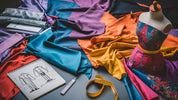
Tips for Buying Unstitched Fabrics for Your Fashion Projects
, by Regal Fabrics, 7 min reading time

, by Regal Fabrics, 7 min reading time
Whether you’re a seasoned fashion designer or a DIY enthusiast looking to create your own garments, choosing the right unstitched fabric is a crucial first step. The fabric you select will determine not only the look and feel of your final product but also its durability and comfort. To help you navigate the world of unstitched fabrics, here’s a guide to the key things you should know before making your purchase.
Before you start shopping, it’s essential to have a clear understanding of what you want to create. Different projects require different types of fabric, and choosing the wrong one can lead to disappointing results. Consider the following:
Fabrics come in a wide range of materials, each with its own characteristics. Here are some common fabric types and their properties:
Understanding the properties of these fabrics will help you choose the right one for your project.
Not all fabrics are created equal, even within the same type. The quality of the fabric can greatly affect the final outcome of your project. When assessing fabric quality, consider the following:
Fabric is typically sold by the yard or meter, but it’s important to also consider the width of the fabric. Most fabrics come in standard widths, usually 44-45 inches or 58-60 inches, but some specialty fabrics may be narrower or wider. Knowing the width will help you determine how much fabric you need to buy for your project.
The way a fabric drapes can significantly impact the look of your finished garment. Before purchasing, try to get a sense of how the fabric falls and moves. You can do this by draping the fabric over your hand or shoulder and observing how it behaves. Some fabrics, like silk and chiffon, have a fluid drape, while others, like denim and canvas, are more structured.
The color and pattern of the fabric are crucial to the overall design of your garment. Here are some things to keep in mind:
Different fabrics require different care. Before purchasing, make sure you understand how the fabric needs to be washed, dried, and ironed. Some fabrics, like wool and silk, may require dry cleaning, while others, like cotton, can be machine washed. Consider the aftercare requirements in relation to the intended use of the garment.
It’s always a good idea to buy a little more fabric than you think you’ll need. This allows for mistakes, shrinkage after washing, or any changes you may decide to make during the project. A general rule of thumb is to purchase 10-20% or half a meter, more fabric than your pattern requires.
If you’re unsure about any aspect of choosing fabric, don’t hesitate to consult with experts. Fabric store employees, tailors, and even online forums can offer valuable advice based on their experience. They can help you make informed decisions and avoid common pitfalls. if you are ordering unstitched fabric online,, you can chat with online, store customer support regarding any questions related to quality, width, minimum length required for your project etc.
ConclusionSelecting the right unstitched fabric is a critical step in any fashion project. By understanding your project’s needs, learning about different fabric types and qualities, and considering factors like drape, color, and aftercare, you can ensure that your finished garment will be exactly what you envisioned. Take your time, do your research, and enjoy the creative process of bringing your fashion ideas to life.